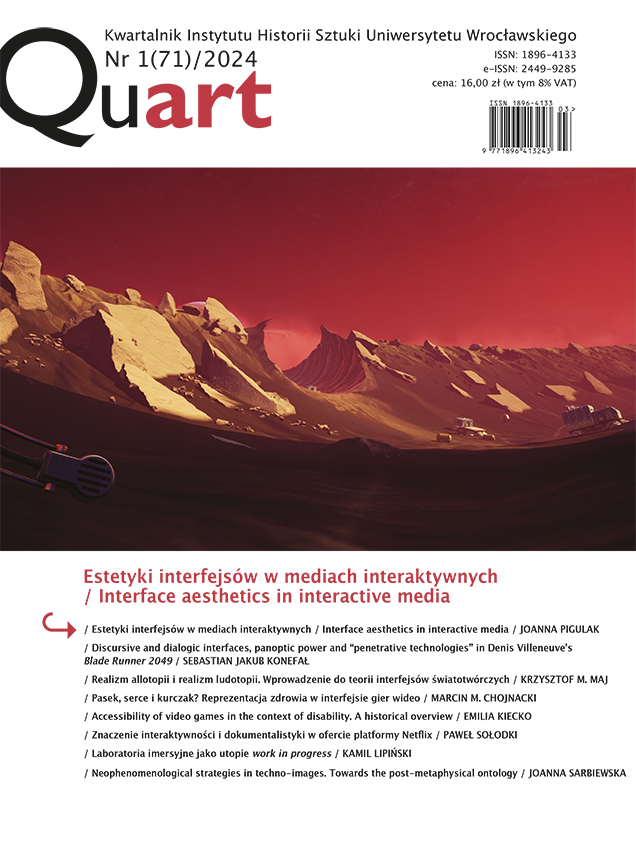

Artykuły

This article briefly presents the history of making video games “accessible” to people with disabilities almost from the beginning of the medium to the present day. It outlines the conditions that influence the current state of accessibility in games, as well as the main issues that have emerged in the discourse on this issue. It also discusses some of the accessibility solutions developed by the video game industry and advocacy organisations.
Aguado-Delgado Juan [et al.], Accessibility in Video Games: A Systematic Review, “Universal Access in the Information Society” 2020, No. 1.
Archambault Dominique [et al.], Towards Generalised Accessibility of Computer Games, [in:] Technologies for E-Learning and Digital Entertainment, Ed. Z. Pan [et al.], Berlin 2008.
Atkinson Matthew T. [et al.], Making the Mainstream Accessible: What’s in a Game? [in:] Computers Helping People with Special Needs. 10th International Conference, ICCHP 2006, Linz, Austria, July 11-13, 2006, Proceedings, Ed. K. Miesenberger [et al.], Berlin 2006.
Brown Mark, Anderson Sky LaRell, Designing for Disability: Evaluating the State of Accessibility Design in Video Games, “Games and Culture” 2020, No. 6.
Cairns Paul [et al.], Enabled Players: The Value of Accessible Digital Games, “Games and Culture” 2019, No. 2.
Galloway Alexander R., The Interface Effect, Cambridge–Malden 2012.
Gałuszka Damian, Gry wideo w perspektywie potrzeb osób niepełnosprawnych, [in:] Oblicza niepełnosprawności w teorii i praktyce, Ed. J. Niedbalski, M. Racław, D. Żuchowska-Skiba, Łódź 2017.
Grammenos Dimitris, Savidis Anthony, Stephanidis Constantine, Designing Universally Accessible Games, “Computers in Entertainment” 2009, No. 1.
Hassan Lobna, Accessibility of Games and Game-based Applications: A Systematic Literature Review and Mapping of Future Directions, “New Media & Society” 2024, in print, https://journals.sagepub.com/doi/epdf/10.1177/14614448231204020 (access date: 2.01.2024).
Karaś Mateusz, Niepełnosprawność, od spojrzenia medycznego do społecznego i Disability Studies, “Przegląd Prawniczy, Ekonomiczny i Społeczny” 2012, No. 4.
McCrindle Rachel J., Symons David, Audio Space Invaders, [in:] Proceedings of the 3rd International Conference on Disability, Virtual Reality and Associated Technologies (ICDVRAT 2000), Ed. P. Sharkey [et al.], Reading 2000.
Nesteriuk Sergio, Audiogames: Accessibility and Inclusion in Digital Entertainment [in:] Digital Human Modeling. Applications in Health, Safety, Ergonomics, and Risk Management: 9th International Conference, DHM 2018, held as part of HCI, Ed. V. G. Duffy, Cham 2018.
Porter John R., Understanding and Addressing Real-world Accessibility Issues in Mainstream Video Games, “ACM SIGACCESS Accessibility and Computing” 2014, No. 108.
Shakespeare Tom, The Social Model of Disability, [in:] The Disability Studies Reader, Ed. L. J. Davis, 3rd Ed., New York – London 2010.
Thompson Aderyn, UX Summit: Accessibility by Design: Finding Our Way on the Path Less Traveled, https://www.gdcvault.com/play/1028893/UX-Summit-Accessibility-by-Design (access date: 20.01.2024).
Watson Nick, Well, I Know this is Going to Sound Very Strange to You, but I Don’t See Myself as a Disabled Person: Identity and Disability, “Disability & Society” 2002, No. 5.
Westin Thomas, Game Accessibility Case Study: “Terraformers” – a Real-time 3D Graphic Game, [in:] Proceedings of the 5th International Conference on Disability, Virtual Reality and Associated Technologies (ICDVRAT 2004), Ed. P. Sharkey, R. McCrindle, D. Brown, Reading 2004.
Westin Thomas [et al.], Advances in Game Accessibility from 2005 to 2010, [in:] Universal Access in Human-Computer Interaction. Users Diversity, Ed. C. Stephanidis, Berlin–Heidelberg 2011.
Yuan Bei, Folmer Eelke, Harris Frederick C. Jr., Game Accessibility: A Survey, “Universal Access in the Information Society” 2011, No. 1.
Zdrodowska Magdalena, Technologia jako narzędzie społecznej dystynkcji. Nieoczywiste relacje techniki i niepełnosprawności, “Kultura Współczesna” 2018, No. 3.